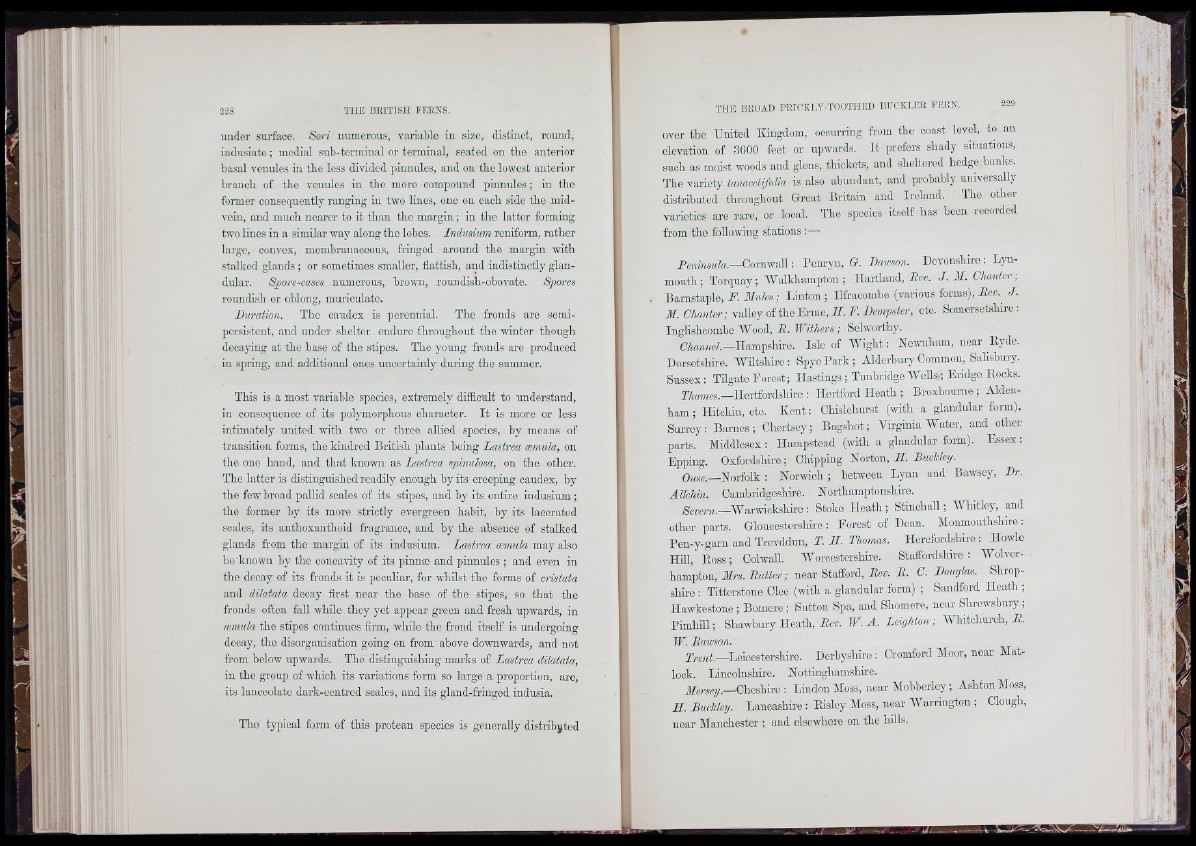
under surface. Sori numerous, variable in size, distinct, round,
indusiate ; medial sub-torminal or terminal, seated on tbe anterior
basal vonulos in the less divided pinnules, and on the lowest anterior
branch of tho vonules in the more compound pinnules ; in tho
former consequently ranging in two lines, one on each side the midvein,
and much nearer to it than tho margin ; in the latter forming
two Kuos in a similar way along the lobos. Indusium reniform, rather
large, convex, niemhranaoeous, fringed around tho margin with
stalked glands ; or sometimes smaller, flattish, and indistinctly glandular.
Sjiore-cases numerous, brovm, roundish-obovate. Sjiores
roundish or oblong, muriculate.
Dtiraiion. The caudex is perennial. The fronds are semi-
persistont, and under shelter endure throughout the winter though
decaying at tho base of the stipes. The young fronds are produced
in spring, and additional ones uncertainly during the summer.
This is a most variable species, extremely difficult to understand,
in consequence of its polymorphous oharactor. I t is more or less
intimately united vdth two or three allied species, hy means of
transition forms, the kindred British plants boing lastrea æmula, on
the ono hand, and that known as lastrea spinulosa, on the other.
The latter is distinguished readily enough hy its creeping caudex, by
the few broad pallid scales of its stipes, and hy its entire indusium ;
the former hy its more strictly evergreen hahit, hy its lacerated
scales, its anthoxanthoid fragrance, and hy the absence of stalked
glands from the margin of its . indusium. lastrea æmula may also
be'known by tho concavity of its pinnæ and pinnules ; and even in
the decay of its fronds it is peculiar, for whilst the forms of cristata
and dilatata decay first near the base of the stipes, so th a t the
fronds often fall while they yet appoar green and fresh upwards, in
æmula the stipes continues firm, while the frond itself is undergoing
decay, the disorganisation going on from above downwards, and not
from below upwards. The distinguishing marks of lastrea dilatata,
in the group of which its variations form so large a proportion, are,
its lanceolate dark-centred scales, and its gland-fringed indusia.
The typical form of this protean species is generally distributed
over the United Kingdom, oocurring from the coast level, to an
elevation of 3600 feet or upwards. I t prefers shady situations,
such as moist woods and glens, thickets, and sheltered hedge hanks.
The variety tanacetifolia is also abundant, and probably universally
distributed throughout Great Britain and Ireland. The other
varieties aro rare, or local. The species itself has boon recorded
from the following stations :—
Peninsula.—Cornwall: Penryn, O. Dawson. Devonshire: Lynmouth;
Torquay; Walkhampton ; Ilartland, Few. J . M. Chanter;
Barnstaple, F. Mules; Linton; Ilfracombe (various forms), J-
M. Chanter; valley of the Erme, IT. U. Deiuyisfer, etc. Somersetshire:
Inglish-combe Wood, R . Withers; Solwortby.
(7/7» , Hampshire. Isle of W ig h t: Newiiham, near Hyde.
Dorsetshire. Wiltshire: SpyoPark; AldcrhuryCommon, Salisbury.
Sussex; Tilgato Forest; Hastings; Tuiihridgo W ells; Fridge Eooks.
y/7»,„es.—Hertfordshire : Hertford Heath ; Broxbourne ; Alden-
h am; Ilitcliin, etc. Kent: Chislehurst (with a glandular form).
Surrey: Barnes ; Chertsoy; Bagshot; Virginia Water, and other
parts. M iddlesex : Hampstead (ivith a glandular form). Essex:
Epping. Oxfordshire ; Chipping Norton, II . Bueldey.
—Norfolk : Norwich ; hotwoon Lynn and Bawsey, Dr.
Allchin. Camhridgcshiro. Northamptonshire.
,5epe)-».—Warwickshire: Stoke Heath; Stinchall; Whitley, and
other parts. Glonoostershirc : Forest of Doan. Monmouthshire:
Pen-y-garn and Trcvddun, T. I I Thomas. Herefordshire : Ilowle
HiU, Eoss; Colwall. Worcestershire. Staffordshire: Wolverhampton,
ITrs. Airffer; near Stafford, Ae®. A. C. Douglas. Shropshire
: Titterstone Clee (with a glandular form) ; Sandford Ilc a th ;
Hawkestone ; Bomere; Sutton Spa, and Shomero, noar Shrewsbury;
PimhUl; Shawbury Heath, Ac®. W. A . Leighton; Whitchurch, A.
W. Baicson.
Trent.—Leicestershire. Derbyshire : Cromford Moor, near Matlock.
Lincolnshire. Nottinghamshire.
Mersey.—Cheshire : Liiidon Moss, near Mohherloy; Ashton Moss,
H. Bucldey. Lancashire: Eisley Moss, near Warrington ; Clough,
near Manchester ; and elsewhere on tho hills.
■I
-J
■ri’ .
i ■
.“■r
1. :
L 1' I